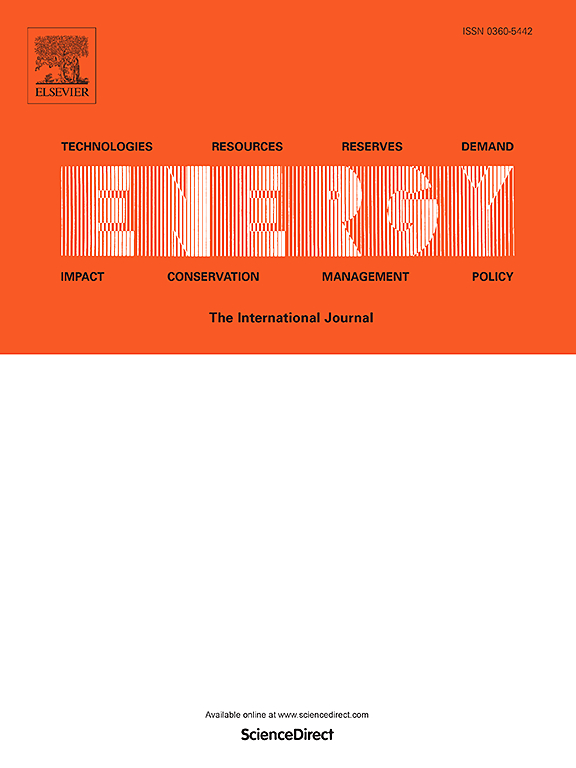Design and evaluation of an integrated CCHP system based on solar thermal supplementary heating and off-peak electrical thermal storage heating
IF 9
1区 工程技术
Q1 ENERGY & FUELS
引用次数: 0
Abstract
Rising demands for heating and cooling, along with the need for grid peak regulation, pose challenges to modern energy systems. Traditional methods such as Combined Cooling, Heating, and Power (CCHP), off-peak thermal storage, and ammonia-water absorption cooling often operate in isolation, making them insufficient to meet the growing demand. Thus, this study introduces an integrated CCHP system that utilizes solar energy and off-peak electricity to enhance grid stability. A case study of a 1000 m2 office building evaluates turbine and generator steam inlet parameters through sensitivity analyses and multi-objective optimization. The evaluation indicates that, in summer, the system achieves a Coefficient of Performance (COP) of 0.75, with exergy efficiency of 44.74 % and system efficiency of 52.63 %. In winter, the exergy efficiency reaches 63.99 %, and the system efficiency is 82.79 %. The system effectively manages 352.12 kW in summer and 269 kW in winter, saving $23,600 annually in operation and maintenance costs. Additionally, it achieves a Levelized Cost of Storage (LCOS) of $0.17/kWh, surpassing coal-fired and reference CCHP systems in system efficiency.
基于太阳能热补充供热和非峰蓄热的综合热电联产系统设计与评价
对供暖和制冷的需求不断增长,加上电网调峰的需求,对现代能源系统构成了挑战。传统的方法,如冷热电联产(CCHP)、非峰值蓄热和氨水吸收式冷却往往是孤立运行的,这使得它们不足以满足日益增长的需求。因此,本研究引入了一种集成的CCHP系统,该系统利用太阳能和非峰值电力来提高电网的稳定性。以1000平方米办公楼为例,通过灵敏度分析和多目标优化对汽轮机和发电机蒸汽进口参数进行了评价。评价结果表明,夏季系统的性能系数(COP)为0.75,火用效率为44.74%,系统效率为52.63%。在冬季,火用效率达到63.99%,系统效率为82.79%。该系统夏季有效管理352.12 kW,冬季有效管理269 kW,每年可节省23600美元的运行和维护成本。此外,它实现了0.17美元/千瓦时的平均存储成本(LCOS),在系统效率方面超过燃煤和参考CCHP系统。
本文章由计算机程序翻译,如有差异,请以英文原文为准。
求助全文
约1分钟内获得全文
求助全文
来源期刊

Energy
工程技术-能源与燃料
CiteScore
15.30
自引率
14.40%
发文量
0
审稿时长
14.2 weeks
期刊介绍:
Energy is a multidisciplinary, international journal that publishes research and analysis in the field of energy engineering. Our aim is to become a leading peer-reviewed platform and a trusted source of information for energy-related topics.
The journal covers a range of areas including mechanical engineering, thermal sciences, and energy analysis. We are particularly interested in research on energy modelling, prediction, integrated energy systems, planning, and management.
Additionally, we welcome papers on energy conservation, efficiency, biomass and bioenergy, renewable energy, electricity supply and demand, energy storage, buildings, and economic and policy issues. These topics should align with our broader multidisciplinary focus.
 求助内容:
求助内容: 应助结果提醒方式:
应助结果提醒方式:


